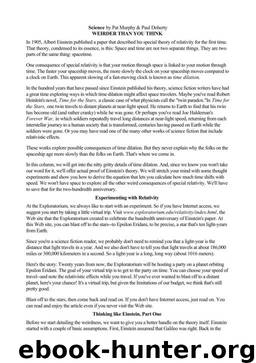Science by Pat Murphy Paul Doherty

Author:Pat Murphy, Paul Doherty [Murphy, Pat & Doherty, Paul]
Format: epub
Tags: Sci-Fi Short
Published: 2010-03-07T00:00:00+00:00
slows down. At ordinary speeds, this slowing is imperceptible (except to a superaccurate clock). But as you approach the speed of light, your clocks slow down to a stop. Just as when the ferry goes almost due north, its eastward speed approaches zero.
* * * *
* * * *
Figure 1.
The left graph shows the situation when you are traveling in a direction between north and east on a ferry that moves at 10 knots. Your speed is always on the arc. Traveling faster to the north means giving up some speed in the eastward direction.
The right graph shows the trade-off between travel through space and travel through time. Your travel through space is measured in fractions of the speed of light, or c. When your speed is 0, you travel through time at the usual rate: One second for you equals one second measured by someone standing still. At 1c, the speed of light, your travel through time stops. Zero seconds pass for you for each second that passes for someone standing still.
Where's the Proof?
Maybe you're skeptical about all this. You want proof? Well, it just so happens we've got proof. Evidence from two different experiments support the existence of time dilation. The first experiment is Pat's favorite. How can you prove that a fast-moving clock runs more slowly than a stationary one? You could send a very accurate clock on a long journey.
In October 1971, two physicists flew four atomic clocks on commercial airliners twice around the world, once in an easterly direction, and once in a westerly direction. These clocks were accurate to within a few nanoseconds. (That's mighty accurate since there are 1,000,000,000 nanoseconds in a second.) Using calculations from the special theory of relativity, the physicists predicted how time measured by the clocks on the planes would differ from time measured by clocks on the ground. What do you know! The experimental results matched the predictions, confirming that time dilation actually does take place with real clocks.
In 1975, physicists tried another experiment. They sent an atomic clock up in a U.S. Navy plane that traveled for 15 hours at 270 knots, or 140 meters per second--about 0.47 millionths the speed of light. As the plane flew back and forth over Chesapeake Bay, the onboard clock was compared to a clock on the ground by laser signal. During the flight, the onboard clock lost 5.6 nanoseconds, exactly the amount predicted by special relativity.
Those who read this column regularly are not surprised. Those faithful readers remember that we mentioned in an earlier column that special relativity is essential to the functioning of the GPS satellite system. The atomic clocks on the satellites run slow due to special relativity because the satellites are whizzing around the Earth in orbit. (They also run fast due to general relativity, but we're not dealing with that theory here. One thing at a time!)
Download
This site does not store any files on its server. We only index and link to content provided by other sites. Please contact the content providers to delete copyright contents if any and email us, we'll remove relevant links or contents immediately.
| Foreign Language Study | History |
| Language Arts | Mathematics |
| Reference | School & Education |
| Science & Technology | Social Science |
| Study Aids |
Pale Blue Dot by Carl Sagan(4915)
Cracking the GRE Premium Edition with 6 Practice Tests, 2015 (Graduate School Test Preparation) by Princeton Review(4227)
Pocahontas by Joseph Bruchac(4183)
Unfiltered by Lily Collins(3965)
The Emotionary: A Dictionary of Words That Don't Exist for Feelings That Do by Eden Sher(3318)
The Daily Stoic by Holiday Ryan & Hanselman Stephen(3235)
Factfulness_Ten Reasons We're Wrong About the World_and Why Things Are Better Than You Think by Hans Rosling(3199)
The President Has Been Shot!": The Assassination of John F. Kennedy by Swanson James L(3056)
The 48 laws of power by Robert Greene & Joost Elffers(3031)
Sapiens and Homo Deus by Yuval Noah Harari(2988)
Rogue Trader by Leeson Nick(2980)
The Innovators: How a Group of Hackers, Geniuses, and Geeks Created the Digital Revolution by Walter Isaacson(2849)
Gettysburg by Iain C. Martin(2786)
The Rape Of Nanking by Iris Chang(2776)
Almost Adulting by Arden Rose(2666)
The Plant Paradox by Dr. Steven R. Gundry M.D(2548)
In the Woods by Tana French(2534)
500 Must-Know AP Microeconomics/Macroeconomics Questions(2532)
Make by Mike Westerfield(2291)
